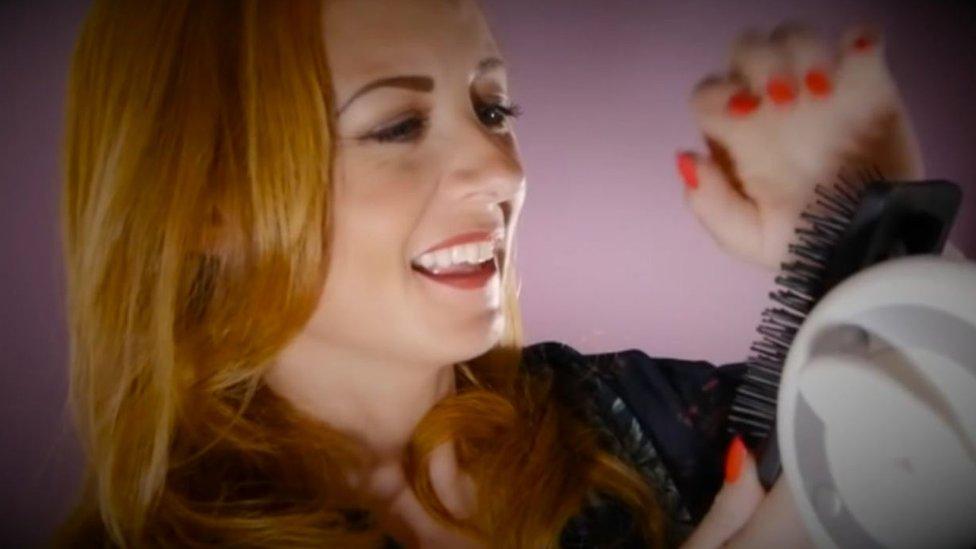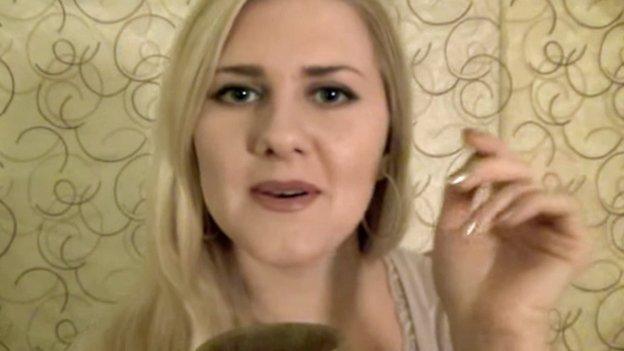ASMR videos 'may have health benefits', study finds
- Published
YouTuber Emma Whispers Red makes ASMR videos - which allegedly cause some people to feel "brain orgasms"
ASMR videos - a YouTube phenomenon based around videos of people brushing hair, folding towels and whispering - may have health benefits, a study says.
A large online community claims the clips provoke an Autonomous Sensory Meridian Response, likened to a warm tingling on the skin, in some viewers.
However, there was little scientific evidence about the phenomenon.
But a new study found the clips could lower heart rates and boost positive emotions in some people.
In recent years, ASMR has become an internet phenomenon, with the term returning 13.5 million results on a YouTube search.
The most popular video producer, Gently Whispering ASMR, has 1.3 million subscribers.

What is ASMR?
The term was coined by American Jennifer Allen, who started a Facebook group on the topic in 2010
It is a physical sensation in response to specific sights and sounds
It is characterized by a tingling feeling that typically starts at the scalp and travels down the spine
There are more than 12 million ASMR videos on YouTube including subjects such people having haircuts, massages and towel-folding tutorials

The University of Sheffield study was the first of its kind, and measured the physiology of those who claimed to experience ASMR.
It found that those who said they felt the sensation had a reduction in their heart rate of about 3.14 beats per minute while watching the videos.
This was, they said, comparable to the effects of relaxation techniques such as mindfulness.
Viewers also showed significant increases in positive emotions, including relaxation and feelings of social connection, researchers said.

The ASMR YouTube star

Emma Smith discovered ASMR when she was struggling to sleep after a car accident. She now makes her own videos online featuring activities such as brushing her hair, ear cupping and finger tapping.
"I was suffering after my car accident so I went on to my phone on to YouTube and thought maybe I could find something to play in the background, some nature sounds, and I ended up coming across ASMR videos. It was then I realised there was a name for this feeling I've always experienced.
"I had a really, really busy mind before I went to sleep; I couldn't just naturally fall asleep easily so watching a video helped me to become present, to focus on one thing and completely relax to the point that I couldn't do anything else."

Report author Dr Giulia Poerio said she was hopeful the study would pave the way for more scientific research into the condition.
"It would be really interesting to look at the potential benefits of ASMR for relieving insomnia, anxiety and depression but there needs to be loads more research including clinical trials," she said.
"However, this is a really good step in understanding ASMR and legitimising it as something people experience."
Marjorie Wallace, chief executive of mental health charity SANE, said although more clinical research was needed it could be another tool to fight mental health conditions.
"We have so little in our weaponry to fight anxiety, stress and insomnia that if people are not only going to find peace of mind but get some pleasure then what's the harm in trying it?"
- Published16 December 2015

- Published16 December 2015

- Published11 December 2014
